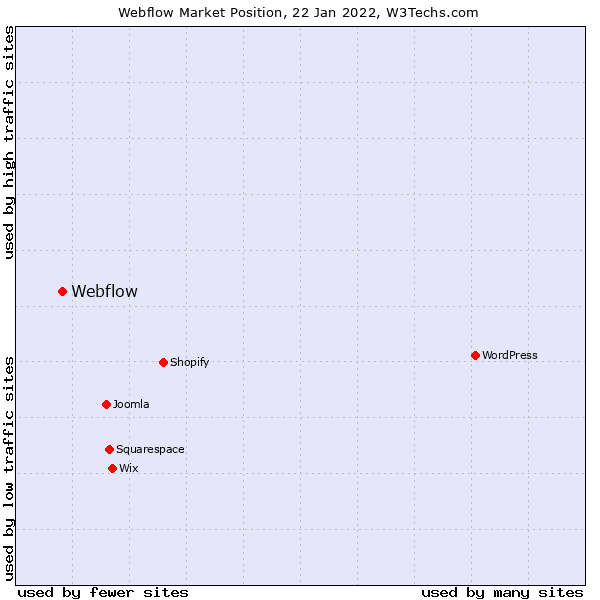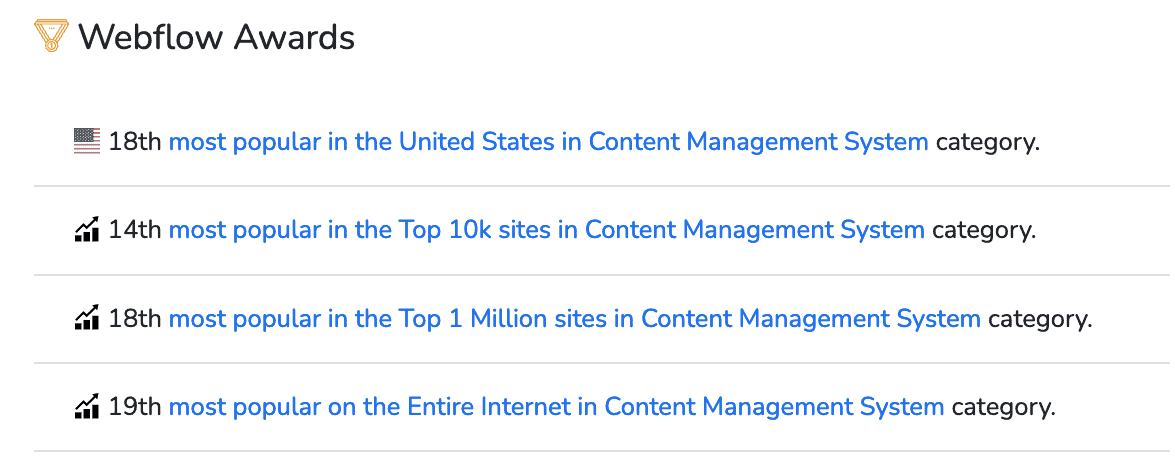Webflow is one of the leading companies in the “no-code” trend, which is sweeping the globe as the most efficient way for companies and individuals to go from design to website launch. Since its founding in 2013, the San Francisco company has created a CMS that is quickly being adopted by many companies, big and small, around the world. But how is this reflected in Webflow’s market share? Read on to find out…
Webflow had humble beginnings
Surprisingly, Webflow didn’t become a huge player in web design overnight. In fact, the company nearly didn’t make it off the ground at all after a failed Kickstarter campaign, being denied funding from Y Combinator, and suffering from tens of thousands of dollars in credit card debt and medical bills. By founder Vlad Magdalin’s own admission, they were at their lowest point within one month of dissolving the company! However, Webflow has experienced quite a turnaround since those humble beginnings.
So how much is the market share of this burgeoning company? Does their massive valuation match their potential? Here’s what we found in our research.
How big is Webflow’s market share?
Currently, Webflow powers only 0.6% of all websites across the entire internet and 0.9% of all websites that use a CMS (according to W3Techs). Compare this to Squarespace’s market share – the platform is used to build 2.0% of all websites and 3.0% of CMS-powered websites, and you see their valuation is comparable to their market share.
Data from w3techs also shows while having only a third of the reach of competitor Squarespace, Webflow actually boasts a higher amount of traffic on their hosted sites.
In fact, this chart from w3techs shows that Webflow sites attract higher traffic on average than sites built on Shopify, Wix, Squarespace, and even the biggest CMS by far, WordPress. (Note this is referring to the open-source CMS, not the private hosting service WordPress.com – you can learn more about how Webflow compares to WordPress.org here.)

While Webflow’s market share is relatively small, it increased quickly between Jan 2021 and Jan 2022 from around 0.25% to 0.4%. All signs point to further growth down the road as more companies adopt the “no-code” approach to web design.
Webflow: moving up the charts!
According to builtwith.com, Webflow is currently ranked as the 18th most popular CMS in the United States and the 19th most popular CMS over the entire internet. When we look a little closer at these numbers we see some interesting trends.
- Top 1M sites: 0.81% built with Webflow
- Top 100K sites: 1.48% built with Webflow
- Top 10K sites: 2.65% built with Webflow
This tells us that Webflow’s small market share is concentrated on highly-trafficked, popular sites.

How Webflow ranks in the CMS categories, according to Builtwith.com
Webflow’s growth is outpacing most of its competitors, growing at an extremely fast rate despite its relatively small market share. These statistics from w3techs indicate Webflow has a good chance of being a serious competitor in the CMS field if their growth continues. The growth achieved by Webflow in 2020 and 2021 is likely to continue as firms big and small opt for the ‘no code’ approach to web design.
| 2018 | 2019 | 2020 | 2021 | May 2022 | |
|---|---|---|---|---|---|
| WordPress | 58.5% | 60.0% | 59.7% | 62.1% | 64.1% |
| Shopify | 1.3% | 1.8% | 2.6% | 3.4% | 6.4% |
| Wix | 0.6% | 0.9% | 1.8% | 2.3% | 3.4% |
| Squarespace | 1.1% | 1.5% | 2.6% | 2.7% | 3.0% |
| Webflow | – | 0.2% | 0.2% | 0.4% | 0.9% |
| Weebly | 0.4% | 0.4% | 0.7% | 0.5% | 0.6% |
| Jimdo | 0.2% | 0.2% | 0.3% | 0.2% | 0.1% |
Webflow has tools for huge firms
One might think large firms would prefer to have dedicated engineers writing the code for their websites, but many are finding that Webflow is powerful enough to fulfill their technical requirements while allowing them to concentrate on design. Some of the most popular websites built with Webflow include Upwork.com, Discord.com, and Crowd1.com.
Webflow is also used by huge firms such as Freshly, Pacific Funds, Rakuten, and Zendesk. Dell uses Webflow to generate their internal websites, like style guides for example, and HelloSign, Dropbox’s e-signature division, uses Webflow to produce their marketing pages. The ability to collaborate within Webflow and their guaranteed 99.99% uptime make it a desirable solution for vital company websites.
Webflow’s “no-code” approach
“No-code” design, as the name indicates, is a way for designers to go from high-spec design to website without any coding knowledge. Many companies are realizing that they can more quickly and inexpensively publish and change their web content using this method, rather than relying on dedicated developers. Webflow is a robust platform for this type of website design and hosting (you can read more in this full Webflow review here).
Webflow’s valuation points to growth
Currently, Webflow is valued at a whopping $2.1 billion. This is after recently securing $140 million in series B funding from venture capital firms Accel and Silversmith. To put that in context, Webflow was worth a reported $400 million only 17 months prior! That means their valuation has grown over five times in that period.
Clearly, there are a lot of folks betting on Webflow’s platform becoming a big contender in the CMS sector. To compare, one of the biggest companies in the CMS world, Squarespace, was valued recently at $10 billion. Another competitor, Wix (which is probably the most similar in terms of features), is valued at around $7 billion. So how does Webflow’s valuation compare with its market share?
Smaller, design-focused firms also favor Webflow
One of the things that sets Webflow apart is that you don’t need coding knowledge, but you’re not stuck with a template either. It allows more design flexibility than a template-based CMS like Squarespace or Wix, so you don’t run the risk of your site looking like everyone else’s.
From Webflow’s showcase of sites you can see the variety of small businesses around the world that have found the no-code approach a great fit for their brand. Parisian record labels, boutique hot sauce companies, and Irish craft brewers (just to name a few) have been able to make visually stunning websites without any deep technical expertise required.

Can Webflow’s market share growth continue?
According to their own website, Webflow has more than 3.5 million users. Over 100,000 customers in 190 different countries build their highly trafficked public sites and vital internal websites on Webflow.
As more tools become available to lower the technical barrier for creating websites and apps, the no-code movement is sure to be a big part of the future. Gartner in its 2019 report indicated that by 2023, so-called “citizen designers” will outnumber professional developers in large organizations by at least four times.
Our research shows that Webflow is currently working on new machine learning algorithms to make it even easier to convert high-spec designs into functional websites. As more firms adopt the no-code approach, and as the tools to make this happen get better and better, there’s a strong chance Webflow will be a big part of that future for decades to come.
Want to learn more about Webflow’s market share? Leave your comments and questions below.
We keep our content up to date
18 May 2022 - Updated numbers
THE BEHIND THE SCENES OF THIS BLOG
This article has been written and researched following a precise methodology.
Our methodology


